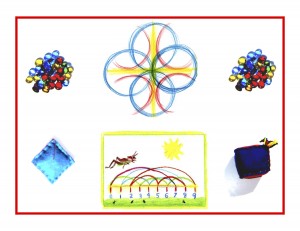Day 81
For one year, 365 days, this blog will address the Common Core Standards from the perspective of creating an alternate, ambient learning environment for math. Ambient is defined as “existing or present on all sides, an all-encompassing atmosphere.” And ambient music is defined as: “Quiet and relaxing with melodies that repeat many times.”
Why ambient? A math teaching style that’s whole and all encompassing, with themes that repeat many times through the years, is most likely to be effective and successful. Today’s post will address the “Reading: Literature” segment of the CCSS Language Arts Standards for Grade 1. There are nine standards, sub-divided into four groups. I will summarize the standards here in blue rather than listing each separately, and then relate ambient content to them, one group at a time.
These standards are a good match with the rich story and literature content of the Waldorf Grade 1 curriculum. However, where the standards say reading, I will substitute “listening and retelling” since first graders have not yet learned to read independently. The Common Core’s approach is “top-down,” meaning that standards designed to produce college and career ready adults are filtered down (and not watered down) from Grade 12 through Kindergarten. “Bottom up” is a more developmentally appropriate approach since it would begin with seed curriculum to produce a healthier (and superior) end result.
The CCSS Language Arts Standards for Reading: Literature, Grade 1:
1) Key Ideas and Details:
Ask and answer questions about details in a text.
Retell stories, including key details, and demonstrate understanding of their central message or lesson.
Describe characters, settings, and major events in a story, using key details.
The Grade 1 fairy tales are retold by the children the next day. The story is taken in whole and of a piece, so there really aren’t any questions to speak of. Rudolf Steiner said that attempting to analyze a fairy tale is like pulling apart a flower. That was directed at adults, so it carries even deeper meaning for children. The stories are recounted in great detail (it really is amazing how much they remember at this age), and are understood at a very deep level, plunging so deep into the child’s consciousness that it is not possible to expect the child to extract abstract meanings like singling out the central message or lesson. Characters and major events are described in exacting detail by the child, with an inherent understanding of their relative importance.
2) Craft and Structure:
Identify words and phrases in stories or poems that suggest feelings or appeal to the senses.
Explain major differences between books that tell stories and books that give information, drawing on a wide reading of a range of text types..
Identify who is telling the story at various points in a text.
The Grade 1 circle time is rich with classic poetry, tongue twisters, songs, and verses. The portions of these that suggest feelings or appeal to the senses are experienced as such by the children. And it is this very immersion in feelings and the senses that make the Grade 1 day so lively and engaging. But again, the children should not be expected to point out specific parts and identify or correlate them with anything else. The literature must stand on its own and exert its good influence without abstract analysis. I suppose if it’s presented concretely rather than abstractly, differences between text types could be pointed out. But this must remain casual and incidental rather than be direct and instructional. Narrative features are appreciated and understood on a deep level, but not taken apart and analyzed now.
3) Integration of Knowledge and Ideas:
Use illustrations and details in a story to describe its characters, setting, or events.
Compare and contrast the adventures and experiences of characters in stories.
Each Grade 1 story is illustrated with a drawing that relates in some way to a letter or number. It is drawn by the teacher and taught to the children, along with a caption that captures significant detail from the story. Compare and contrast is a more advanced essay writing tool that is best saved for later grades.
4) Range of Reading and Level of Text Complexity:
With prompting and support, read prose and poetry of appropriate complexity for Grade 1.
The children learn an impressive number of classic poems and verses over the course of the Grade 1 year. A great amount of excellent literature is covered because stories are heard, not read, and poems are learned by heart. Because the limitation of grade-level (simplified) texts is removed by lifting the requirement of the first graders actually having to read them, the innate intelligence of the child is met with reverence and respect, by including a good deal of quality, complex material.
Knowledge ensues in an environment dedicated to imaginative, creative knowing, where student and teacher alike surrender to the ensuing of that knowledge as a worthy goal. We will be heading back to math tomorrow, though not the Common Core just yet. I will not be covering the College and Career Readiness Anchor Standards portion of the Language Arts Common Core since these standards are, in my opinion, way beyond what a first grader needs to know or is capable of learning.












